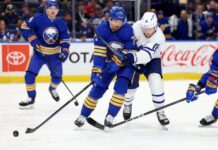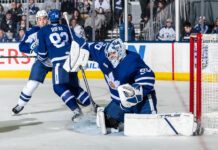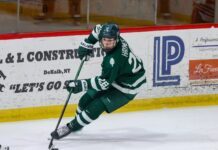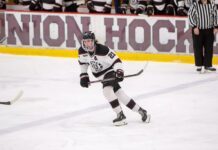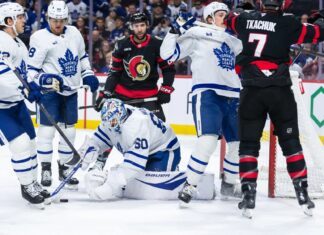Returning more or less the same group from last season, it’s no secret that the Toronto Maple Leafs’ blue line is the biggest question mark on what is otherwise a contention-calibre roster.
It goes without saying that if John Tavares picked another destination and the Leafs didn’t address their blue line beyond a depth KHL signing (Igor Ozhiganov), the perception of Kyle Dubas’ first offseason would have been vastly different compared to the giddy atmosphere that currently surrounds Leafs Nation. The addition of a top-10 center who plays a complete game, drives play and gives the Leafs a three-headed monster down the middle transforms the roster and its deployment in such a way that there is reason to believe the team could also benefit defensively from such a massive signing, on top of their already-good offense getting even better.
As far as the gameplan for growth on the blueline itself, it’s going to be about improvement from within and on the margins. For a team with the Leafs overall skill level, they did not own the puck as much as Kyle Dubas and Mike Babcock would have liked. At 5v5, their control of shot attempts (49.82%) ranked 17th in the NHL and their share of the shots on goal (48.38%) ranked 23rd.
Partly that’s an issue with the forward group’s down-low heaviness and ability to generate a sustained cycle game (which Tavares helps with to an extent), but the Leafs could also break the puck out much better than they did for large portions of last year. That’s a five-man-unit problem, but it could be helped significantly by a blue line group that transitions the puck more cleanly and efficiently. Getting the puck into the forwards’ hands as quickly as possible – and keeping it for as long as possible — is going to be imperative in order to maximize the Leafs’ major strengths as a team up front.
In that regard, the full-time addition of a Travis Dermott and potentially the arrival of Justin Holl on the bottom pairing in Roman Polak’s former spot could aid the transition game. Rebuilding Nikita Zaitsev’s confidence when it comes to making plays – he reached a point last season where he seemed totally lost and was throwing pucks away with regularity – is also a key piece to the puzzle, as is another step forward by Morgan Rielly and a repeat of last regular season by Jake Gardiner, who has to put the Bruins series behind him entering a contract year.
Pairing #1: Morgan Rielly – Ron Hainsey
There have been a number of lineup projections this summer that have advocated for a Jake Gardiner – Morgan Rielly top pairing, and there is some logic to it. Especially with the Bruins series fresh on the minds of Leafs fans and pundits, having Ron Hainsey and Nikita Zaitsev back on the right side of the top four doesn’t seem like the solution to the problems that ail the Leafs blue line.
But it is difficult to see the coaching staff moving away from this pairing at least to start the year, primarily because Babcock trusts Hainsey to play the right side (his off side) and get him defensive stops in key situations against tough competition. Hainsey is an on-ice surrogate for Babcock; a steady veteran presence who is vocal, settles things down, and takes control when it comes to organizing the team off of a key defensive zone draw in late-game situations. Hainsey also seemed to free Rielly up to get more involved offensively and the two generally seemed to click on and off the ice right from the beginning of the season.
The on-ice results from this pairing were adequate for the top match-up role – they more or less split the shot attempts (1013 for, 1038 against), scoring chances (507 for, 505 against) and goals share (45 for, 45 against) in their 1,022 minutes together at 5v5 during the regular season. While they weren’t actually outscored as a pairing while on the ice together at 5v5, they got buried in the postseason possession-wise in their assignment against the Bruins’ vaunted top line, finishing the series with a 37% possession share. Even if the Leafs survived the onslaught more often than not with the pairing on the ice, having the puck so little has a deleterious knock-on effect when it comes to momentum and how it sets up the next shift.
Hainsey was struggling to keep his head above water in the Boston series and showed clear signs of wear and fatigue. If this pairing is going to be a mainstay on the blue line again, it seems imperative that the coaching staff prioritizes more rest for the 37 year old. Leading the league in penalty kill time all season long – which are gruelling minutes for a defenseman – and playing 20 minutes a night against top competition over 82 games, and then expecting Hainsey to be at his best come playoff time, is too big of an ask.
As for Rielly, he was far and away the Leafs’ best defenseman in the playoffs for the second year in a row, and he is coming off of a career year points wise (52, 15th among defensemen in the NHL) while taking steps forward as a leader on and off the ice. Can he take another step and cement himself as a credible #1D in the league? That’s as big of a question as any on the Leafs blueline as the organization enters a season in which its top four is unchanged from last season.
Pairing #2: Jake Gardiner – Nikita Zaitsev
When it comes to the biggest individual disappointments of 2017-18, Nikita Zaitsev’s performance coming off of a new seven-year contract ranks high among them. While one playoff game does not a season make, Jake Gardiner’s Game 7 showing is also right up there. This pairing has a lot to prove, then, with Gardiner entering a contract year and Zaitsev in need of a bounce-back season.
For Zaitsev, a full healthy season is a good place to start — he’s missed a fair bit of time dating back to the Washington series in the 2017 playoffs and has played through a couple of injuries — as he looks to rebuild his confidence, which became an issue for him last year. Babcock’s praise of his game in the face of obvious struggles – at his lowest points, he seemed to be battling a case of the yips with the puck and endured some hard-to-watch, trainwreck-style shifts – would suggest there was a crisis of confidence happening behind the scenes. As his confidence has wavered, Zaitsev has often defaulted to puck-off-the-glass plays and can be prone to running around defensively.
Zaitsev has started well in each of his two seasons as a Leaf; in his first, he was coming off of the World Cup of Hockey appearance for Team Russia and played some solid hockey as a rookie, and in the second, his pairing alongside Gardiner got off to a good start in 2017-18. It’s a matter of whether he can sustain that level of play and avoid the injury bug that can be detrimental to a player’s momentum and confidence throughout the year.
Gardiner, meanwhile, is coming off of a career year in points and also his most significant adversity as a Leaf coming off of Game 7 of the Bruins series. This pairing broke even in GF% (39 goals for, 36 against) at 5v5 last regular season but was in the red as far as possession (48.9% CF, uncharacteristic for a Gardiner pairing). So long as Hainsey remains on the right, though, it is difficult to picture a scenario in which this isn’t Babcock’s #2 pairing to start.
One reason for optimism here in general is that the Leafs’ top four D are going to get more shifts with an elite center on the ice with the addition of Tavares to go along with Matthews. Both centers provide a reliable breakout outlet who can take less-than-perfect passes and turn them into offense – leading to more successful exits, more successful entries with control, and more cycle time at the other end.
Pairing #3: Travis Dermott – Justin Holl
Extras: Connor Carrick, Igor Ozhiganov (Marlies to start)
As tempting as it is to pencil Travis Dermott into the top four, trust and responsibility is going to have to be earned under Babcock. There is also something to be said for Dermott growing his game and his confidence against bottom-pair competition in the NHL before he’s exposed to big minutes and tough matchups. Dermott could earn his way up the lineup sooner than later and is a significant piece of the Leafs blue line going forward, but it’s unlikely he’ll be handed anything right out of camp.
The 22-year-old was heavily sheltered in the playoffs with 13:22 in ice time per game during the Bruins series after seeing around 16:00 of ice per night in his 37 regular season games. It’s easy to get impatient with Babcock when it comes to taking the reigns off and rewarding the young talent on the team, but to his credit, it’s hard to name a player that’s taken a step back developmentally in his time here.
The right side of this pairing is wide open with the departure of veteran defenseman Roman Polak, who walked as an FA and signed in Dallas. Those of the thinking that former Marlies are more likely to be rewarded with Dubas in the GM’s chair might lean towards Holl here; while Dubas certainly has created a situation in which Holl has a good fighting chance at claiming the spot out of camp – the Leafs GM didn’t re-sign Polak or add a veteran right-handed option for the bottom pair — ultimately the coach sets the lineup and there is going to be significant weight placed on a consideration like the penalty kill. There are also contract factors; as committed as he seems to making a go of it in North America, KHL signing Igor Ozhiganov does have a European assignment clause in his deal that would allow him to return to Russia if he’s not on the big club roster by a certain date (for a number of European signings in the past, that date has been December 15th).
Holl has earned a good hard look at camp after his showing for the Marlies — including a strong Calder Cup playoff campaign and brief cameo for the Leafs – and he fits the blue line identity the Leafs are looking to foster, one that is built on mobility, puck moving and ability to jump up and contribute to a fluid five-man attack.
The big question mark here is how much rope a pairing that consists of Dermott – Holl/Ozhiganov/Carrick would receive from Babcock, who has had one of his security blankets taken away from him with the departure of Polak.
For opening night forward line projections, see Part 1: Projecting the Toronto Maple Leafs’ 2018-19 Opening Night Forward Lines






